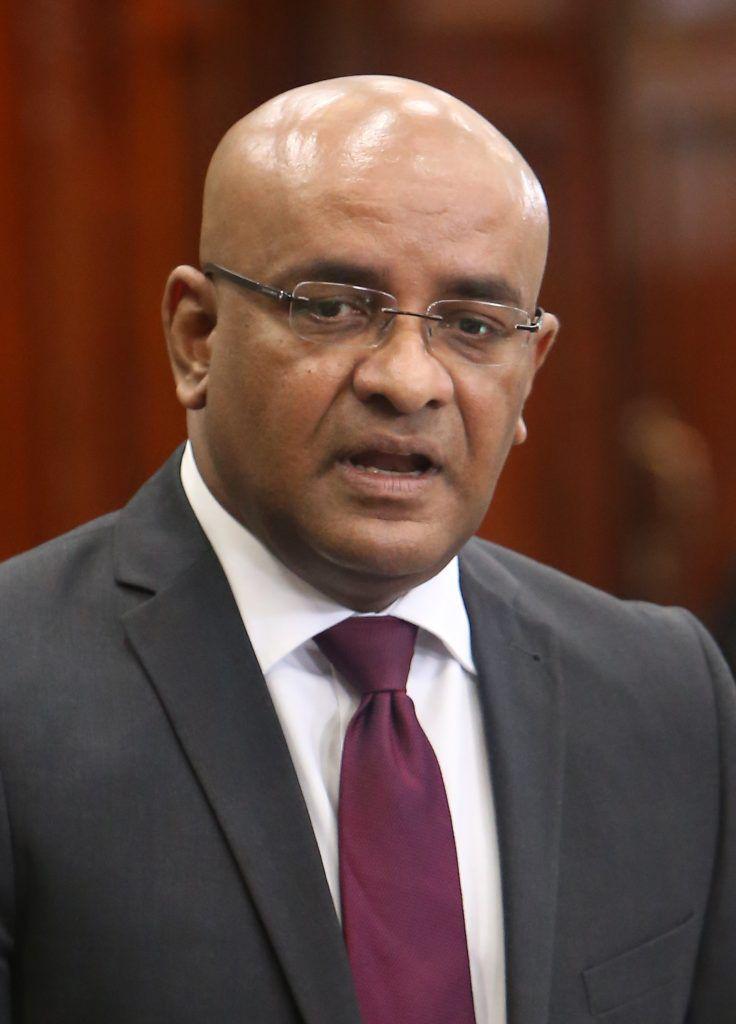Latest update March 19th, 2025 5:46 AM
Latest News
- ExxonMobil commences “busiest year yet”
- With eyes on Guyana, Chevron buys 5% of Hess shares
- Another ExxonM study warns of impact to fish from degraded water quality
- Over 400 hundred dead, thousands beneath the rubble in one night
- Guyanese man drowns after jumping into Takatu River to escape bee attack
Govt.’s draft gas strategy falls short in outlining achievable steps for Guyana’s gas monetization
Nov 01, 2023 ExxonMobil, News, Oil & Gas
Kaieteur News – The Government of Guyana (GOG) on Monday unveiled its draft Gas Monetization Strategy for public consultation. This strategy is a pivotal roadmap aimed at managing the nation’s substantial gas resources. It also plays a crucial role in helping Guyana make informed decisions concerning the use of these gas resources.
However, from an analysis of the document, it is evident that the strategy leaves much to be desired in terms of concrete, achievable steps for gas monetization.
Guyana is actively pursuing the use of natural gas in the Liza One and Liza Two fields for the Gas-to-Energy (GTE) project. ExxonMobil Guyana will fund a 12-inch pipeline for transporting the resource to Wales, where a Natural Gas Liquids (NGL) plant will treat and separate the gas for use in the power plant. The power plant aims to generate 300 megawatts of electricity for the national grid and produce products like cooking gas for sale, aligning with the administration’s goal of energy self-sufficiency. Despite some expert concerns about the project’s nearly US$2 billion cost, the government remains resolute about its viability.
Vice President, Bharrat Jagdeo, had previously been enthusiastic about releasing the draft gas strategy for public input, highlighting its significance in the government’s broader plan to monetize the substantial 17 trillion cubic feet of gas discovered in the Stabroek Block. He emphatically stated, “We’ve made it clear; we want to monetize our gas assets. This strategy will outline our approach to the industry.”
Yet, as citizens begin to analyze the document for the two-week period, it is essential to remember that ongoing exploration and appraisal activities are still underway to determine the full extent of Guyana’s gas reserves. This uncertainty adds an extra layer of complexity to the monetization strategy.
The draft gas strategy extensively discusses the various options available for the utilization of natural gas, but falls short of providing a clear and detailed roadmap for Guyana to transform these options into reality. This discrepancy raises questions about the feasibility and practicability of the government’s approach.
The document dedicates a significant portion to the role of natural gas in the energy transition. It highlights natural gas as a cleaner and lower CO2-emitting alternative to coal, gasoline, and diesel. It further mentions the significant growth in renewables, emphasizing the value of natural gas, particularly through Combined Cycle Gas Turbines (CCGTs), as a short to medium-term solution to complement intermittent renewables.
The consultants who prepared the strategy stressed that technological advancements have made renewable energy more affordable, but natural gas remains competitive due to its reliability and efficiency. Despite the growth of solar power, the draft document maintains that natural gas for power generation continues to be competitive, even in the face of falling renewable energy costs.
The document states, “Natural gas is an abundant, reliable, and low-cost fuel when compared to most energy sources and is particularly well suited as a competitive and economical solution in power generation, complementing renewables intermittency.” It specifically highlights CCGTs as the most efficient thermal power generation technology.
In this context, it was stated that it is essential to recognize that CCGTs can be developed and constructed much faster than other thermal and nuclear plants. While constructing a CCGT power plant typically takes two to three years, nuclear plants can take up to seven years, and coal plants up to five years. This emphasis on natural gas’s reliability and efficiency is undoubtedly crucial in the energy transition, as it can provide a reliable source of power while renewable technologies continue to evolve.
The document also emphasizes the role of natural gas in balancing power generation requirements as coal and oil-based fuels contribute less in today’s world where governments are pushing for cleaner environmental policies. The transition to renewable energy is ongoing, but given the current high cost and technological limitations, renewables cannot provide an affordable and reliable grid availability to meet growing power demands. Natural gas, particularly in the form of CCGTs, is identified as a key player in bridging this gap during the energy transition.
The draft strategy underscores the complexity and challenges of monetizing indigenous gas reserves to the best advantage. It acknowledges the presence of multiple, often conflicting, financial, political, and economic forces that impact the process. Aligning the interests of the host government, upstream companies, and other stakeholders is recognized as a significant challenge, involving factors such as domestic market requirements, development costs, local market affordability, and export options.
The document states, “There are a range of options available for utilization of natural gas,” and it includes a graphic sourced from the United States Department of Energy, outlining these options.
In the section on gas monetization routes, the document acknowledges gas-to-power generation as a potential route, citing the Government’s Gas-to-Energy project set to begin in late 2024. It was stated that the growing electricity demand in Guyana is expected to create opportunities for a gas-fired power plant to meet commercial and residential demand for electricity. Also, it was noted that access to more reliable and affordable power generation can incentivize the development of new industries, creating jobs and driving economic growth.
The estimated additional firm capacity required in Guyana by 2035 to cover peak capacity plus reserve margins is approximately 250 MW, according to the Low Carbon Development Strategy (LCDS). This makes the current 50 MMscf/d (Million standard cubic feet per day) feedstock level the most viable option. However, the potential electricity supply gap depends on the extent and timing of renewable energy deployment in the country.
Methanol
Methanol production is another option discussed in the draft strategy. It explains that Methanol is a typical natural gas monetization route for sales into the global petrochemicals and fuels markets. Methanol is produced from natural gas via a Synthesis gas (also known as syngas) process. The consultants note that Methanol is a globally important commodity chemical, with China being the largest producer and consumer, accounting for about 60% of methanol use.
The document highlights the growth of methanol use in the fuel sector due to its clean combustion characteristics. They added too that many countries are promoting methanol blending into gasoline for automotive use, and it’s also gaining popularity as a marine fuel due to its lower emissions compared to heavy fuel oil. Methanol has diverse applications, including in gasoline additives, biodiesel production, and other fuel-based products.
It’s important to note that while the consultants highlight the potential of methanol and its competitiveness, they do not provide a comprehensive strategy for Guyana to develop its natural gas resources for methanol production.
Liquefied Natural Gas (LNG)
Liquefied Natural Gas (LNG) is overviewed in the draft strategy. It is explained that LNG is natural gas cooled to a liquid state to occupy a much smaller volume. The document acknowledges the complexity of LNG value chains and mentions the reliance on long-term contracts to underpin significant capital investments and risks across the value chain.
It was also pointed out that the number of countries producing LNG almost doubled from 12 to 23 between 2000 and 2022. However, despite the substantial LNG production capacity under construction globally, there is still a need for additional LNG supply to sustain long-term demand growth post-2026. Once again, the draft strategy fails to provide a detailed roadmap for Guyana to enter the LNG market.
Ammonia/ Urea
The document explores ammonia and urea production as a natural gas monetization route for sales into global fertilizer markets. It highlights the demand for urea as fertilizer and identifies China and India as the two largest consumers. The consultants mention price fluctuations in recent years, especially in 2021 and 2022, which saw urea prices peaking at significant levels.
The draft strategy suggests that the war in Ukraine has created export constraints and extremely high gas feedstock prices in Europe, driving urea prices to record levels. It estimates urea prices in the US Gulf Coast (USGC) market and assumes that a world-scale urea plant in Guyana could capture similar prices.
Still, the document falls short of presenting a clear plan for Guyana to capitalize on the potential of ammonia and urea production.
Blue Ammonia / Hydrogen
Hydrogen and its potential role in the fight against climate change are mentioned in the draft strategy but no clear steps for Guyana to take that route.
“Green and blue hydrogen can be utilized in sectors that are difficult to decarbonize, such as steelmaking, and as a long-distance transport fuel. Green hydrogen requires access to significant renewable energy sources, whereas blue hydrogen requires access to Carbon Capture and Storage technology and CO2 transportation networks that have yet to be proven and developed in Guyana,” it was mentioned.
Given this potential, it was explained that governments and industry leaders around the world are increasingly focusing their efforts on building out the infrastructure necessary to support a hydrogen economy.
To access the Guyana Gas Monetisation Strategy and participate in the public consultation, please visit the ministry’s official website at https://petroleum.gov.gy/.
The deadline for the public consultation is November 14, 2023.
Share this:
- Click to print (Opens in new window)
- Click to email a link to a friend (Opens in new window)
- Click to share on Facebook (Opens in new window)
- Click to share on WhatsApp (Opens in new window)
- Click to share on Twitter (Opens in new window)
- Click to share on Pinterest (Opens in new window)
- Click to share on Pocket (Opens in new window)
- Click to share on Tumblr (Opens in new window)
- Click to share on Reddit (Opens in new window)
- Click to share on LinkedIn (Opens in new window)
Related
Similar Articles

The Glenn Lall Show|| March, 17th, 2025
Follow on Tik Tok @Glennlall
THE BLUNT OF THE DAY

Sports
Mar 19, 2025
-20 teams from 16 countries registered for One Guyana 3×3 Quest Kaieteur Sports- The Maloney Pacers, one of the most experienced squads in the Caribbean, will represent Trinidad and Tobago at...Features/Columnists
America does not fight for free
Peeping Tom… Kaieteur News- Guyana must be wary of America. That much is clear. The United States has recently issued... more
If Guyana’s President Ali is the “Zelensky of the Caribbean”, who is the Putin?
Antigua and Barbuda’s Ambassador to the US and the OAS, Ronald Sanders By Sir Ronald Sanders Kaieteur News- In the latest... more
Publisher’s Note
Freedom of speech is our core value at Kaieteur News. If the letter/e-mail you sent was not published, and you believe that its contents were not libellous, let us know, please contact us by phone or email.
Feel free to send us your comments and/or criticisms.
Contact: 624-6456; 225-8452; 225-8458; 225-8463; 225-8465; 225-8473 or 225-8491.
Or by Email: [email protected] / [email protected]
Weekend Cartoon

















